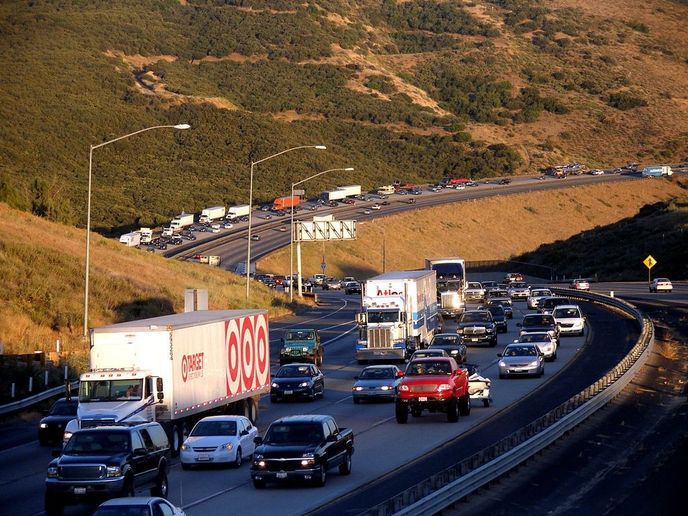Keep Fleets in Mind When Considering the Country’s First Proposed Electric Truck Standard
In California, the transportation sector alone accounts for 41% of total greenhouse gas (GHG) emissions and is a major contributor to oxides of nitrogen (NOx) and particulate matter (PM) emissions.
Last week, the California Air Resources Board (CARB) released details of its proposed Advanced Clean Truck rule, which would become nation’s first zero-emission vehicle (ZEV) standard. The rule would require truck manufacturers to sell increasing percentages of electric models from model years 2024 to 2030.
The rule proposes that in 2024, ZEV sales — battery electric (BEV) or hydrogen-powered fuel cell electric truck/chassis — would need to be 7% of Class 4 to Class 8 straight trucks sales and 3% of all other truck sales. By 2030, ZEV truck/chassis sales would need to be 50% of Class 4 to 8 straight trucks sales and 15% of all other truck sales.
CARB is not undertaking this lightly, as evidenced in its 50-plus page “statement of reasons” document. As always, CARB is doing its due diligence with stakeholders. However, knowing the state of the electric truck market today, requiring half of all Class 4 to 8 trucks sold in 10 years to be ZEV will be a monumental task.
Fleets can rest easy. While California fleets are having to comply with CARB’s increasingly stringent rules governing diesel trucks, this proposed rule dictates what truck manufacturers can sell in the state, not what fleets must buy.
That’s a big part of the problem. This new rule forces truck OEMs to manufacture and sell electric trucks without a tested market of buyers.
The last time CARB issued a ZEV standard wasn’t that long ago. In 2012, CARB mandated that automakers that sell at least 60,000 ZEVs a year based on a percentage of total California sales. Failure to meet the targets would result in losing the ability to sell any vehicle in California.
Thus, electric “compliance cars” were born. Remember the Chevrolet Spark EV, Fiat 500e, Honda Fit EV, and Ford Focus EV? Manufacturers created these vehicles with one goal only, to satisfy California’s ZEV sales requirements.
Compliance EVs were sold in small numbers, relying a market of first adopter consumers that could afford to take a chance with the new technology. Those buyers’ overall capitalized costs were reasonable enough. Charging infrastructure was easily solved with an inexpensive Level 2 home charger. As a second vehicle, range was less of an issue. Few worried about what their EVs would fetch in the used car market (which was very little).
Electric trucks are a different story. They’ll be used by fleets with a vast array of duty cycles. They’ll need to be upfitted to their task. Installing the charging infrastructure requires working with utilities that haven’t yet figured out how they’ll get the required amount of electricity to fleets’ charging depots, which will be exponentially more expensive and intricate than home charging. In some areas that amount of power isn’t even available, because the present infrastructure isn’t built to carry that load.
You can see how reaching this sales target within 10 years feels like we’re throwing darts blind.
This all doesn’t negate the fact that California has the worst air pollution in the country, and the biggest single contributors to that pollution are on wheels — medium- and heavy-duty trucks. In California, the transportation sector alone accounts for 41% of total greenhouse gas (GHG) emissions and is a major contributor to oxides of nitrogen (NOx) and particulate matter (PM) emissions.
These emissions have a definable health cost, from lung infection, asthma, and cancer.
So yeah, something needs to be done. CARB is in great part responsible for California’s leadership position when it comes to proliferation of electric cars. However, the zero-emission passenger car mandate produced many cars that consumers weren’t ready for.
There will be no “compliance trucks.” We don’t have that luxury when it comes to the fleet market.
Originally posted on Fleet Forward
Author
 Chris Brown
Chris Brown
Executive Editor
Source: https://www.truckinginfo.com
FLEET MANAGEMENT AUDIT
Fleet management is the use of a set of vehicles in order to provide services to a third-party, or to perform a task for our organization, in the most efficient and productive manner with a determined level of service and cost.
Fleet management activities are shown in the following graph 1:

Graph 1: fleet management activities
The proposal audit analyses and assesses all fleet management activities shown in the graph 1, and its main goals are:
- Know the overall status of the fleet management activities
- Provide the analysis, the assessment, the advice, the suggestions and the actions to take in order to cut costs and increase the efficiency and efficacy of the fleet management activities
With the information obtained, we’ll elaborate a report that holds the overall status of the fleet management as well as the suggestions, recommendations and the measures to take in order to cut costs and optimize the fleet management activities.
CLICK ON THE FOLLOWING LINK TO DOWNLOAD THE PROPOSED FLEET MANAGEMENT AUDIT:
Fleet Management Audit AFMC
Contact:
José Miguel Fernández Gómez
34 678254874
info@advancedfleetmanagementconsulting.com



